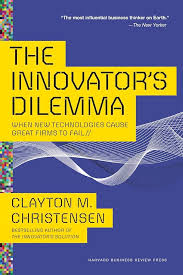The Innovator's Dilemma, Competing Against Luck, and Zero to One: A Comprehensive Analysis
Introduction
In the ever-evolving landscape of innovation, businesses face a myriad of challenges. Two seminal works, "The Innovator's Dilemma" by Clayton Christensen and "Zero to One" by Peter Thiel, offer profound insights into the complexities of innovation and the strategies required to build enduring businesses. These works, when combined with the principles outlined in "Competing Against Luck" by Clayton Christensen, provide a comprehensive framework for navigating the uncertain path to innovation success.
The Innovator's Dilemma: A Tale of Disruptive Innovation
Clayton Christensen's "The Innovator's Dilemma" explores the concept of disruptive innovation, where established companies, driven by the desire to satisfy their existing customers, often fail to capitalize on emerging technologies and markets. This dilemma arises from the inherent tension between sustaining innovation, which involves improving existing products and services, and disruptive innovation, which introduces radically new offerings that often initially underperform in terms of traditional metrics.
Key Takeaways:
- The Value Network: Established companies are deeply embedded in value networks, which include suppliers, customers, and complementary products. Disruptive innovations often challenge these networks, leading to resistance and inertia.
- The Resource Allocation Process: Traditional resource allocation processes prioritize projects with high returns on investment, often overlooking disruptive innovations that may initially appear less profitable.
- The Overemphasis on Customer Needs: Focusing solely on the needs of existing customers can blind companies to emerging opportunities and the potential of disruptive technologies.
Competing Against Luck: The Power of Jobs-to-Be-Done
Clayton Christensen's "Competing Against Luck" introduces the concept of "Jobs-to-Be-Done," which shifts the focus from understanding customer needs to understanding the jobs that customers are trying to accomplish. By identifying these jobs, companies can develop products and services that truly solve customer problems, rather than simply offering incremental improvements to existing solutions.
Key Takeaways:
- The Job Story: Understanding the job story, which includes the functional, emotional, and social dimensions of a job, allows companies to develop products that resonate with customers on a deeper level.
- The Importance of Context: The context in which a job is performed is crucial, as it influences the specific needs and preferences of customers.
- The Role of Habit: Habits play a significant role in customer behavior, and breaking old habits can be challenging. Companies must design products that seamlessly integrate into customers' lives.
Zero to One: Building the Future
Peter Thiel's "Zero to One" emphasizes the importance of creating new things rather than copying existing ones. He argues that the path to sustainable growth lies in building monopolies, not competing in crowded markets.
Key Takeaways:
- The Importance of Secrets: Successful companies often have secrets, which could be proprietary technology, unique business models, or strong brand loyalty.
- The Power of Definite Optimism: Believing in the possibility of creating something new is essential for innovation.
- The Role of Technology: Technology can be a powerful tool for creating new markets and disrupting existing ones.
Integrating the Frameworks: A Comprehensive Approach to Innovation
By combining the insights from these three books, we can develop a comprehensive approach to innovation:
- Identify the Job-to-Be-Done: Use the Jobs-to-Be-Done framework to understand the underlying needs and desires of customers.
- Disrupt the Value Network: Consider how to disrupt existing value networks by introducing innovative products or services that challenge the status quo.
- Create a Monopoly: Focus on building a sustainable business by creating a monopoly in a specific market or niche.
- Embrace Definite Optimism: Cultivate a culture of innovation and risk-taking, encouraging employees to think big and challenge conventional wisdom.
- Leverage Technology: Use technology to create new products, services, and business models.
Case Studies
- Airbnb: Disrupted the hospitality industry by focusing on the job of finding affordable and unique accommodations.
- Tesla: Challenged the traditional automotive industry with electric vehicles and autonomous driving technology.
- Amazon: Revolutionized e-commerce by offering a wide range of products and services, leveraging technology to improve customer experience.
Conclusion
By understanding the principles outlined in "The Innovator's Dilemma," "Competing Against Luck," and "Zero to One," businesses can navigate the complexities of innovation and build enduring success. By combining a deep understanding of customer needs, a willingness to disrupt existing markets, and a focus on creating unique value, companies can position themselves for long-term growth and prosperity.



